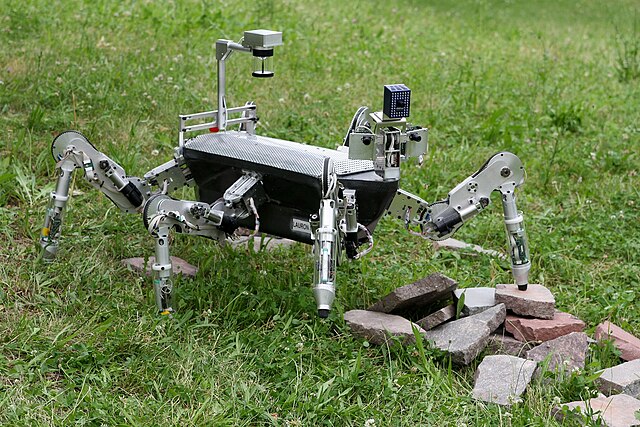Line 29:
==Models==
===INSECT (since approx. 1992)===
The work on the LAURON project started in the early 1990s with some basic research and modeling of wooden leg prototypes. In 1992 the first wooden prototype of a complete six-legged walking robot, called INSECT, was built at the Forschungszentrum Information (FZI) at the University Karlsruhe (Germany). This prototype had no actuators, but was able to measure its joint angles of the legs with potentiometers.{{CN|date=April 2014}}
===LAURON I (since approx. 1994)===
[[File:Sechsbeiniger Laufroboter LAURON aus dem Jahr 1995 im Deutschen Museum in München entwickelt vom Forschungszentrum Informatik, Karlsruhe.jpg|thumb|LAURON I - now in the biggest german museum of science and technology [[Deutsches Museum]]]]
LAURON I was finished in late 1993 and then presented to public at the CeBit 1994. It was constructed of aluminum and fiber-reinforced plastics with an overall weight of 11 kg. The robot was controlled by artificial neural networks. The construction and design was strongly inspired by the stick insect. For example,the ratios of the leg segments to each other were similar to ratios found in the stick insect [[Carausius morosus|Carausius Morosus]].{{CN|date=April 2014}}
===LAURON II (since approx. 1995)===
At the end of 1994 the second generation of LAURON was developed. The main features were a changed mechanical design and some additional sensors like force sensors in the feet and an inclinometer. Because the new legs were now build of aluminum the overall weight of LAURON II increased to 16 kg. LAURON II was used as a test platform for validating various control strategies and for machine learning.{{CN|date=April 2014}}
===LAURON III (since approx. 1999)===
Line 45 ⟶ 35:
===LAURON IV (since approx. 2004)===
The fourth generation of LAURON was finished in 2004.<ref name="LR3">{{cite book |url=http://ieeexplore.ieee.org/search/freesrchabstract.jsp?tp=&arnumber=5626328&queryText%3Droennau%26openedRefinements%3D*%26searchField%3DSearch+All# |title=Design and kinematics of a biologically-inspired leg for a six-legged walking machine|publisher= 2010 3rd IEEE RAS and EMBS International Conference on Biomedical Robotics and Biomechatronics (BioRob), Tokyo, Japan, 2010.}}</ref> The mechanical robustness was improved, for example the round cord belt connecting the joints with the motors were replaced by gear belts. Beside, a new head with 2 degrees of freedom was added. The central body was now made of light-weight carbon fiber. LAURON IV weights 27 kg including its accumulators and can reach a maximum walking speed of up to 0.22 m/s. Furthermore, the used NiMH accumulators can supply LAURON with energy for up to 60 minutes. The current version of the fourth LAURON generation is LAURON IVc.<ref name="LR1"/> The LAURON IV won the Faulhaber University Project Award in 2011.<ref>{{cite news | url=http://www.robotics.org/content-detail.cfm/Industrial-Robotics-News/Nature-Inspired-Robotics-FAULHABER-University-Project-Award-Winner-2011/content_id/3044 | title=Nature-Inspired Robotics: FAULHABER University Project Award Winner (2011) | date=September 22, 2011 | work=Robotics Online | accessdate=April 3, 2014}}</ref>
===LAURON V (since approx. 2013)===
The fifth LAURON generation was introduced and demonstrated at the [[International Conference on Robotics and Automation]] (ICRA) 2013 in Karlsruhe Germany. The flexibility and maneuverability of LAURON V was improved by adding an additional rotational joint to each leg close to the main body. This joint enlarged each leg's workspace and allows LAURON to orient its feet towards the ground. The mounting angles of the six legs were optimized to additionally increase the overall workspace, improve the support polygon and enable LAURON V to manipulate objects with its front legs. With its insect like kinematic structure and behavior-based control system LAURON is able to cope with difficult, rough terrain and is well suited for inspection and search and rescue tasks. LAURON V was evaluated at the EU-Taranis international field exercise as robust and flexible search and rescue robot.{{CN|date=April 2014}}
{{Portal|Robotics}}
|  Article Images
Article Images